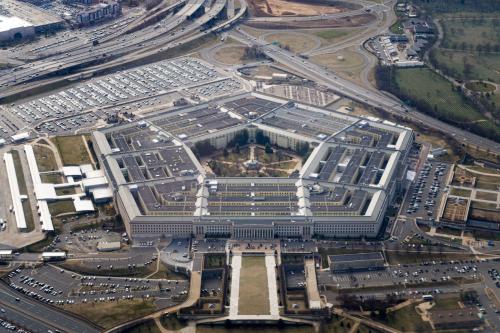

Upcoming Event
1775 Massachusetts Ave., NW
Washington, DC
The Saban Center for Middle East Policy hosted a policy luncheon to discuss the ongoing debate surrounding Israel’s security barrier. Leading the discussion were two experts on the issue: Isabel Kershner, Senior Editor of The Jerusalem Report and author of the recently published Barrier: The Seam of the Israeli-Palestinian Conflict, and David Makovsky, Senior Fellow and Director of The Project on the Middle East Peace Process at The Washington Institute for Near East Policy, author of A Defensible Fence: Fighting Terror and Enabling a Two State Solution (2004). The discussion examined the formation of Israel’s barrier policy, as well as the implication of the barrier for Israel’s security and Israeli-Palestinian reconciliation.
Isabel Kershner began the session with a short history of Israel’s security barrier, crediting Ehud Barak with generating the strategy of unilateral disengagement that the barrier is a part of. During the 2000 Camp David summit, then Prime Minister Ehud Barak and his advisors came up with the idea of “initiated separation”—unilaterally determining Israel’s borders—as a last resort if there was no credible Palestinian negotiating partner. Ironically, Kershner noted that at that time Ariel Sharon, who was then in opposition but is now the prime minister, did not agree with Barak’s strategy and was a vocal critic of the barrier during the 2001 election campaign. Sharon’s criticism rested on the fact that the security barrier would leave a large portion of his key constituency, Israeli settlers in the Palestinian territories, on the other side of the fence as it is often called. However, high levels of terrorism and subsequent pressure from the Israeli public to increase security led Sharon to approve construction of the barrier. The barrier soon became known as “Sharon’s Way,” which along with unilateral disengagement has become the cornerstone of the platform of Sharon’s newly formed Kadima Party. Although Kershner argued that the barrier was constructed in response to security needs, it has become the anchor of Israel’s disengagement policy.
David Makovsky argued that the idea of unilateral disengagement originated with Yitzhak Rabin who declared in 1992 that there should be a separation of Israelis and Palestinians. Makovsky noted that one reason Sharon originally opposed the construction of the barrier was because it would create a de-facto Palestinian state on the other side of the barrier’s boundary.
Kershner said that while a majority of Israelis support construction of the security barrier—approximately 85 percent—most are unsure as to its exact route. In addition, many Israelis are unaware that only 35 percent of the barrier has been completed. Kershner argued that the fact that the fence is incomplete highlights hesitation on the part of Israelis—while the concept of a barrier receives high levels of support from citizens and government officials, many Israelis have some hesitation over its route.
Kershner noted that the route of the fence was not planned by a central government committee or agency. Rather, multiple agencies and groups have played a role in determining the barrier’s current and future path: the Israeli government, the White House, settlers, and Israel’s Supreme Court. For this reason, Kershner argued, there is little accountability over parts of the barrier’s route. As an example of the improvised nature of the route, Kershner presented the case of Alfei Menashe, a settlement that under original plans would have fallen outside of the barrier’s boundary and so been separated from Israel proper. When the mayor of Alfei Menashe discovered that the barrier would not enclose his town, he protested until prime minister Sharon ultimately included Alfei Manashe within the barrier’s route. It is incidents such as this, Kershner claimed, that are responsible for the odd shape of the barrier in its current state.
Regarding the route of the barrier, Makovsky drew attention to the role of the Israel Defense Forces (IDF) and the White House. Though playing no role in the policy debate, the IDF plays a major role in deciding whether to implement the barrier policy. For instance, the Israeli government voted to have the barrier run in the Jordan Valley, along the eastern side of the Palestinian territories. The IDF, however, refused to construct this portion, arguing that it would be neither practical nor humane to encircle the Palestinian population. Makovsky also stressed the role of the White House, noting that there have been numerous policy discussions between Israeli and U.S. officials. It was in these discussions, Makovsky argued, that the United States pressed Israel to alter portions of the barrier’s route to ease hardship on the Palestinians. Makovsky also noted that Israel’s Supreme Court plays an important role as a “check” on the barrier policy, ensuring that it is implemented in a proper manner that accounts for Palestinian claims.
Kershner argued that while the barrier has been successful in addressing Israel’s immediate security needs, it will not solve Israel’s long-term security needs. As long as Israel unilaterally decides the route of the fence there will be increased tension levels in Palestinian territories. Kershner warned that Kassam rockets, which are being fired over the fence from Gaza, may soon be fired at Israel from the West Bank. In essence, the more Israel implements policies that frustrate Palestinians, the greater the chances of radicalization among Palestinians.
Kershner continued with a brief examination of the psychological impact that the barrier has on Israelis and Palestinians. Regarding Israelis, Kershner stated that the barrier not only provides Israelis with a greater sense of security, but makes the notion of disengagement more tangible. At the same time, however, Palestinians face increased frustrations; freedom of movement is greatly restricted and as such Palestinians are separated from their jobs and schools. Kershner argued that Palestinians value freedom more than statehood, evidenced by the fact that many would not be happy with a Palestinian state whose borders are defined by Israel’s barrier.
During the question and answer session, Kershner claimed that Israel may be using the barrier to phase out Palestinian labor in Israel. She acknowledged that Israel has constructed terminals along the route of the barrier designed to handle the entry of Palestinian laborers into Israel, but she noted that the passes required for each laborer to enter Israel have yet to be handed out. Makovsky took issue with this, claiming that Israel had brought in foreigner workers to replace Palestinian labor as early as 1993, far before a barrier was even envisioned.
Both Kershner and Makovsky stated that the barrier alone cannot solve the conflict. Makovsky argued that it is only a starting point; Israel and the Palestinian Authority must begin negotiations over permanent status issues.

Darrell M. West
September 16, 2024

Michael E. O’Hanlon
September 12, 2024

Allison Minor
September 3, 2024